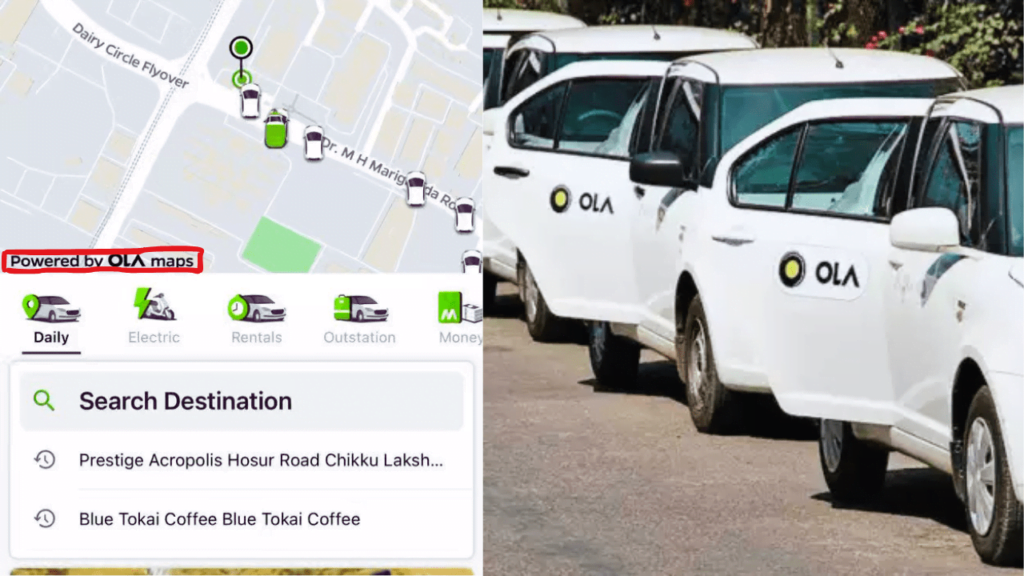Ola Cabs’ decision to transition from Google Maps to its in-house Ola Maps marks a significant step in the company’s journey towards technological self-reliance and cost efficiency. This move is expected to save the company Rs 100 crore annually.

In a strategic move towards self-reliance, Ola Cabs has announced its complete transition from Google Maps to its in-house developed Ola Maps. This significant change is expected to save the company around Rs 100 crore annually, a noteworthy achievement in cost reduction and technological independence.
Bhavish Aggarwal, the co-founder and Chairman of Ola Group, shared the news on X (formerly Twitter), emphasizing the cost benefits and new features that Ola Maps will bring to the table. “After exiting Azure last month, we’ve now completely moved away from Google Maps. We used to spend Rs 100 crore a year, but this month, that expense has dropped to zero by switching entirely to our in-house Ola Maps! Please check your Ola app and update it if necessary,” Bhavish Aggarwal posted.
The Transition Journey: From Google Maps to Ola Maps
Ola’s decision to develop and implement its own mapping solution marks a significant milestone in its journey toward vertical integration. The transition follows closely on the heels of Ola’s exit from Microsoft’s Azure cloud service, which was completed last month. This move to Ola Maps aligns with the company’s broader strategy of reducing dependency on third-party providers and enhancing in-house capabilities.
The development of Ola Maps has been facilitated by the acquisition of GeoSpoc, a Pune-based geospatial services provider, in October 2021. This acquisition has played a crucial role in building the technological foundation for Ola Maps, allowing the ride-hailing giant to offer advanced mapping and location services tailored to its specific needs.
Ola Maps: Features and Future Prospects
Ola Maps is set to offer several innovative features in the coming months. These include street view, neural radiance fields, indoor images, 3D maps, and drone maps, which will significantly enhance the user experience. Additionally, the Ola Maps API will be available on the Krutrim cloud, providing developers with advanced location intelligence services.
Bhavish Aggarwal highlighted that Ola Maps is not just limited to the company’s ride-hailing app but will also be integrated into its electric two-wheelers. This integration will be part of a software update scheduled for January, further extending the reach and utility of Ola Maps.
The Role of Krutrim AI and Cloud Services
Ola’s transition to Ola Maps is part of a broader strategy to leverage its in-house AI and cloud capabilities. Krutrim, Ola’s AI company, has emerged as a key player in this transition. Established in December last year, Krutrim has quickly grown into a startup unicorn, launching its cloud services, Krutrim Cloud, in May. The cloud platform has already attracted 2,500 developers, underscoring its potential in the market.
Krutrim Cloud offers a range of services, including AI computing and mapping solutions. These services are designed to support the diverse needs of developers, providing them with robust tools to build and deploy location-based applications. The integration of Ola Maps into Krutrim Cloud further enhances the platform’s capabilities, offering advanced mapping and location intelligence services.
Cost Savings and Strategic Independence
The decision to develop and implement Ola Maps is primarily driven by cost considerations and the desire for greater strategic independence. By eliminating the need to rely on Google Maps, Ola Cabs can save approximately Rs 100 crore annually. This cost reduction is significant, providing the company with additional resources to invest in other strategic initiatives.
Moreover, the shift to in-house solutions aligns with Ola’s broader strategy of vertical integration. By controlling its own mapping and cloud infrastructure, the company can reduce its dependency on external suppliers and enhance its operational efficiency. This strategic independence also positions Ola to better navigate the rapidly evolving technological landscape, enabling it to adapt more quickly to changing market conditions and customer needs.
Ola’s Broader Technological Vision
The transition to Ola Maps is just one part of Ola’s broader technological vision. The company is also investing in research on solid-state batteries for its electric scooters, with plans to integrate these innovative batteries into its products by next year. This research is being conducted at Ola’s new gigafactory in Tamil Nadu, which is expected to play a key role in the company’s efforts to advance battery technology.
According to Bhavish Aggarwal, the development of solid-state batteries is still in the early stages, but the company is optimistic about their potential. These batteries are expected to offer significant advantages over traditional lithium-ion batteries, including higher energy density, longer lifespan, and improved safety. By investing in this cutting-edge technology, Ola aims to enhance the performance and competitiveness of its electric scooters.
Summary
Ola Cabs’ decision to transition from Google Maps to its in-house Ola Maps marks a significant step in the company’s journey towards technological self-reliance and cost efficiency. This move is expected to save the company Rs 100 crore annually, while also providing a platform for introducing advanced mapping features and services.
The integration of Ola Maps into the company’s ride-hailing app and electric two-wheelers demonstrates the versatility and potential of this in-house solution. Furthermore, the role of Krutrim AI and Cloud services in supporting this transition highlights Ola’s broader strategy of leveraging advanced AI and cloud technologies to drive innovation and operational efficiency.
As Ola continues to invest in new technologies, such as solid-state batteries, the company is well-positioned to lead the way in the rapidly evolving mobility and transportation industry. The shift to Ola Maps is a clear indication of the company’s commitment to innovation and strategic independence, paving the way for future growth and success.
Read Next:

The Psychology of Love: Why Valentines Day Matters More Epic Than You Think
Discover the psychology of love and why Valentines Day is more important than you think. Learn how love impacts the brain, strengthens relationships, and boosts

Premier League Highlights: Arsenal Humiliate Man City 5-1, Spurs and Palace Secure Crucial Wins
Arsenal demolished Manchester City 5-1 in a statement premier league highlights win, reigniting their title hopes. Meanwhile, Crystal Palace stunned Man United 2-0, and Tottenham

How Budget 2025 Impacts the Indian Middle-Class: Major Tax Benefits and Glaring Omissions
Budget 2025 offers major tax relief to the middle class, including zero tax on incomes up to ₹12 lakh. However, it misses out on incentives

Degrees vs Employability: Why “Highly Qualified Degree Holders” Struggle to Find Jobs While “Less Qualified Individuals” Get Hired Faster!
Many highly qualified individuals struggle to secure jobs, while less qualified candidates get hired quickly. This Degrees vs Employability paradox is caused by employer preferences,

The Power of Mindset: Why Looking Poor Doesn’t Make You Poor, but Thinking Poor Does!
Discover why looking poor doesn’t define your wealth but thinking poor does. Learn the power of mindset and how a growth-oriented mindset can lead to

Overthinking: How It’s Damaging Today’s Youth – Causes and Cure in 2025
Understanding how overthinking is silently damaging today’s youth, from its causes rooted in societal pressure and social media to its long-term effects on mental health.
